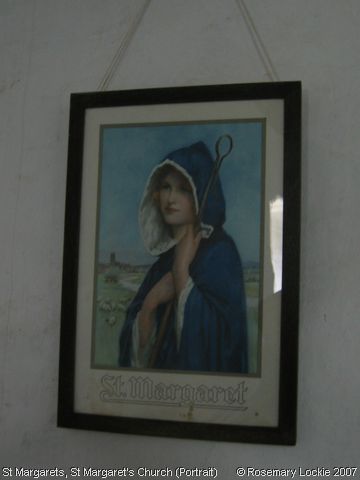St Margaret's Church, St Margarets (Portrait)
The story of St Margaret as symbolised in the
East Window are described on a board near to this painting as follows:
The East Window
St Margaret, V.M. at Antioch in Pisidia 3rd to 4th Century AD
Patroness of this Church and Parish.
Subject
The Saint is shown nearing the Holy City - to suggest her life and hereafter -
‘an outward and visible sign of inward and spiritual grace’ - imaging the
eternal beauty of Holiness.
Margaret
She is very young, as at the time of her martyrdom, and of great beauty. Of
noble birth, she became a shepherdess when, on the discovery of her faith,
she was driven from her father's house. As such she is seen here - led by all
the transitory loveliness of the countryside to muse on the Beauty that will
last - the Pearl of Great Price after which she is named - “The Name Margaret
signifieth ‘Pearl’”, (Golden Legend). On her arm she bears this Church, one
of her 261 dedications in Britain.
The Pearl Gate
Whilst a shepherdess of sheep, the Lamb points her to the Pearl she has
found - the Gate of Heaven itself, the ‘Pearl of Price’ (M. 13.46)
symbolising the Incarnation of the Son of God, the most precious factor
in eternity - through which we enter heaven: for it is, as Margaret has
discovered, the Gate of Heaven (Rev. 21.21).
The Holy City
‘The City lieth foursquare’ (Rev. 21.16) In the midst of the Tree of Life
(Rev. 22.2) - that life indeed which is the goal of the search for the
pervasive Beauty of God - Our Lady and the Holy Child being the essence
of Life and Light. The City is set amidst hills (Ps 121.1) - with ‘a
river of water of life, bright as crystal’ (Rev. 22.1) issuing from the
roots of the TGree, flowing through the pearl portals, falling in
cascades over ‘all manner of precious stones’ (Rev. 21.19) to the meadows
around Margaret's feet (like the streams which thread the hills around her
shrine). So, the rills of Grace from the Holy Trinity - ‘streams of living
waters, Springing from Eternal Love’ - which ‘make glad the City of God’
(Ps. 46.4) unite earth to heaven - that life to this.
Legenda
Beneath the figure of the Saint - Invenia Margartia (‘Having found the Pearl’)
suggests M. ??, 45, 46, each sincere child of God being ‘a pearl-merchant’
(Margaritarius) seeking goodly pearls, also a pearl in his sight - each
Saint ‘having found The Pearl’.
Beneath the Holy City is the divine commentary on M. 13.46 - ‘Each one of
the several gates was of one Pearl’ (Rev. 21.21)
Similitudes
In the design, the border of oak leaves surrounding both panels, the meadows
and groves of oak and yew and bramble are from the landscape of this shrine
of the Lady Margaret. The device on her shield relates to her victory over
the evil one; her blue mantle betokens faithfulness even unto death and she
wears the martyr's crown of life deck'd with pearls. The wild lilies and
roses are symbols of purity, beauty and the peace of heaven. The ‘Pearl’
and ‘Daisy’ are English renderings of her Greek name ‘Margaret’.
In the universal language of symbolism, the design shows:-
(1) The Response of the soul to the Call of love. ‘Rise up my love, my fair
one, and come away. For, lo, the winter is past’ - pearl finding and
answering to Pearl - ‘my beloved is mine and I am His’ (Song of Songs).
(2) Under the similitude of the Holy City, the beloved disciple figures the
One Holy Catholic and Apostolic Church perfected as ‘the Bride - the Lamb's
wife’.
The artist's treatment of the whole suggests the mystic union of that life
with this - declared in the words: ‘Behold I make all things new’ for
‘as many as I love’.
(Information provided by Rosemary Lockie)
Image contributed by Rosemary Lockie on 8th August 2007.
